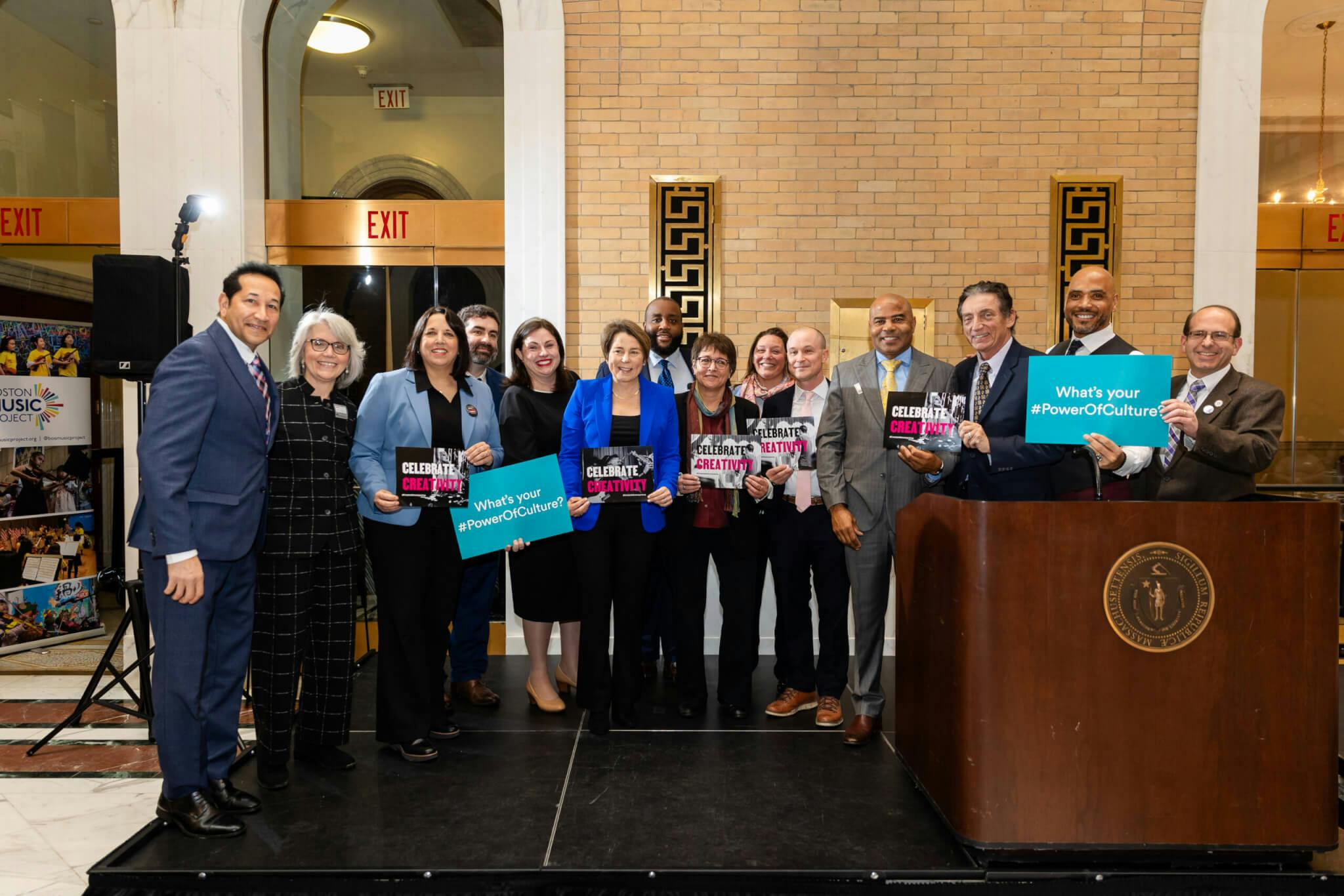In January, MASSCreative celebrated Creative Sector Advocacy Week, a time for conferring with elected officials about the importance of the arts, organizing within the community, and sharing joyful performances, displays, and demonstrations. It was also an opportunity for lawmakers to hear from their constituents about the value of the five bills that make up the Creative Sector Legislative Agenda. These originated from efforts by MASSCreative, the Commonwealth’s arts advocacy organization that is partnering with legislators, cross-sector allies, and arts leaders from across the state to advance the acts. Emily Ruddock, executive director of MASSCreative, said during an interview following the event that the bills stemmed from community members’ responses during a series of in-person and virtual meetings held during November and December of 2022.
Ruddock said that during these sessions, participants were asked how their worlds had changed in the aftermath of COVID-19. “Our sector is really different from what it was before. [We asked], what are the things that you are most worried about and feel need to be addressed in a post-pandemic Massachusetts? What could government do to shift that?” Ruddock said. She added, “What [the bills] all have in common is they are rooted in expressed needs from the creative sector.”
January 24 was both when the Massachusetts State House transformed into the venue for Creative Sector Day and when Governor Maura Healey released her funding recommendations for fiscal year 2025. She revealed that Mass Cultural Council could receive approximately $25.5 million during what she called a belt-tightening year. This represents a $500,000 increase since last year’s amount. Michael Bobbitt, executive director of Mass Cultural Council said that he was excited to hear the news.
“We had proposed [an increase to] $28 million,” Bobbitt said. “… That was a hope and a dream. This is the beginning of the process. We’re hoping that it doesn’t go lower than [$25.5 million] when it goes through the Senate and the House, and we’d be very happy if it goes above that. … To see that the arts has been prioritized is a [positive] sign that the state and governor appreciate [creativity] the way that I know them to.”
The creative sector not only strengthens community, builds cultural identity, and offers social benefits, but it plays a critical role in sustaining our economy, according to a press release from MASSCreative. The arts support employment opportunities and generate revenue on local, state, and federal levels. Over the past few years, we’ve seen the tangible impact that the sector has had on our financial livelihood, both within Massachusetts and on a national scale.
“In 2023, the National Endowment for the Arts (NEA) and the US Bureau of Economic Analysis reported on the national- and state-level contributions of the arts and cultural sector to the nation’s GDP,” the press release reads. “In 2021, arts and cultural production in Massachusetts generated $27.2 billion in economic impact, created 135,181 jobs, and contributed towards 4.2% of the state’s economy.”
There are still more steps that constituents can take to advocate for the creative sector at a policy level. The five bills that MASSCreative is working to advance are currently in committees and need to receive favorable reports from members by today, February 7, to move forward. By the end of July, the public will know if a bill has passed. Ruddock said that supporters of the arts can reach out to their legislators to express how essential the bills are. Here’s what the Creative Sector Legislative Agenda calls for:
The Creative Space Preservation Act
This bill seeks to address the problem of the loss of creative spaces for artists by establishing some definitions. “Creative space restriction” would be added as a land restriction category in Massachusetts General Laws, something that has never happened before. This gives cities and towns the language to dedicate properties to arts activities, defining “creative space” as a place where “the primary use is the creation and practice of art, culture, and creative expression” and “presentation space” as one where art can be showcased. The legislation would also allow cities and towns to create a Municipal Creative Space Trust Fund to help create and preserve these kinds of spaces.
The Cultural Equity in Tourism Grant
Tourists are often drawn to a limited set of attractions in Massachusetts. This act would create a grant to finance tourism marketing and promotional expenses for arts and cultural organizations. Funds could support the production of various materials, such as tourism publications, press kits, billboards, and media advertisements. Most importantly, the grant would prioritize the amplification of “the stories of historically marginalized or underrepresented cultures.”
The ACE Act
The Accessibility in the Creative Economy (ACE) Fund strives to support individuals with disabilities. It would offer grants to arts, culture, humanities, and interpretive science organizations to remove barriers that people with disabilities face. For example, an exhibit could be experienced as too bright and loud by a child on the autism spectrum, and funding might be used to adapt the program, Ruddock explained. A tactile exhibit that is too high for a person in a wheelchair to reach could also be redesigned to meet that need.
The PLACE Act
The Program for Local Art and Community Engagement (PLACE) would create a public art fund by dedicating a percentage of construction costs from Commonwealth-owned properties and new public construction projects that exceed $200,000. A PLACE Commission, made up of thirteen members, would determine that public art pieces “reflect the cultures and people where the public art is installed.”
The Downtown Vitality Act
Small businesses have been heavily impacted by the popularity of online retail. This bill would allocate five percent of receipts from online sales in Massachusetts “to support staffing and operations” of main street associations, cultural districts, business improvement districts, and more in Gateway Cities and low-income neighborhoods. André Leroux, director of the Gateway Hubs Project at MassINC, was involved in the development of this act and said that many local downtowns and commercial districts have struggled to become thriving business centers.
“In order to create these wonderful places, where people will actually get out of their cars and spend money, they need to be unique and dynamic,” Leroux said. “Cultural development and a sense of place really provides that.”
Ruddock emphasized that the Creative Sector Legislative Agenda will address unique challenges that artists in Massachusetts are presently facing, such as the loss of work and exhibition spaces in the Commonwealth and the absence of a statewide percent-for-art bill that would support public art. Many of the Creative Sector Legislative Agenda acts strive to address inequities and social disparities, like the Cultural Equity in Tourism Grant, which recognizes that visitors to Massachusetts don’t often hear about the pasts of marginalized communities.
“We’re a very old state. We have a lot of firsts, a lot of historical moments,” Ruddock said. “And some of those are really well known; others of those aren’t. The stories and the histories of communities that have been underrepresented and marginalized don’t tend to be the ones that we know the best and don’t tend to be the ones that are most able to advertise themselves.”
Bobbitt said that he is optimistic about what the passage of these bills could mean for the creative sector. The positive impact of the arts is one that can be felt across communities.
“Everyone benefits from the arts. Some of the crises that we have in the state, like mental health [crises] and social isolation, the tenseness of being on opposite ends of society, all this stuff can be supported by the arts,” Bobbitt said. “The arts are a tool to help us feel better… to find creative ways to see that our disagreements can come together for the collective good.”
This is a developing story. Information about which bills will move forward will be updated.
Update, 4/15: On April 10, the House Committee on Ways and Means announced their proposed spending plan for FY25, dedicating $25.9 million to Mass Cultural Council. That value is a 2% increase over Healey’s H.2 allocation and a 3.58% increase over FY24’s record-making investment of $25 million for the organization.

